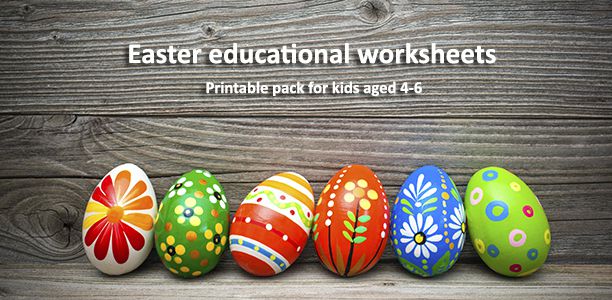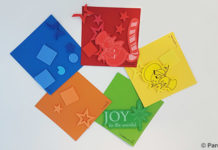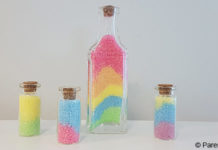Age
4-6 years
Duration of activity
Theses worksheets can be used to fill in a spare ten minutes. But if your child loves writing and colouring they’ll probably spend much longer and want to repeat their favourite worksheets again and again.
Materials/equipment
- Printable Easter educational worksheets for 4-6 year olds
- Colouring pencils, crayons or textas

- Laminating machine and laminating pouches (Optional- for re-usable worksheets)
- Multipurpose spray and a cloth (Optional- for wiping clean laminated worksheets)
- A workspace with a flat surface for writing
Cost
The worksheets cost very little to print out and you’ll probably already have coloured pencils or felt pens in your child’s activity box.
Making the worksheets re-useable
If you want to laminate the worksheets to make them re-usable, you can buy a $20 laminator and plastic laminating sheets (pack of 50 for about $8) from a stationary store e.g. Officeworks. But laminating will save lots of money in the long run because you can use the same worksheet over and over again, even store and use for the next sibling when your first child has outgrown them.
Preparation
- Print the entire set of 4-6 year old worksheets or pick and choose the ones your child wants to do.
- Laminate some or all of the worksheets if you want to reuse them- use a separate pouch for each sheet and run it through the laminating machine.
- Put the pencils or textas as well as the worksheets at your child’s desk or the area they use for writing and colouring.
What to do
Activity 1 – Matching Easter baskets with the same number of eggs worksheet
- Take the worksheet and sit down with your child to discuss it. Look at the different baskets, talk about characteristics such as their shape and colour and count the number of eggs in each basket in the left hand column.
- Ask your child to read the instructions on the worksheet. Help them if they struggle with some of the words.
- Instruct your child to count the number of eggs in the first basket in the left hand column and find the basket in the right hand column with the same number of eggs. Help them if they get stuck.
- When they have identified the matching basket in the right column, instruct them to draw a straight line between the two baskets. Encourage them to draw the line as straight as possible as this will be more challenging and better help them develop their fine motor skills.
- Repeat until all the Easter baskets in the left column have been joined to the baskets in the right column with the same number of eggs.
Activity 2 – Colour matching patterns on the Easter Eggs
- Take the worksheet for this activity and discuss it with your child. Talk about the Easter eggs they see, for example the shape, pattern and how many there are. Ask them which pattern they like the best and which colours they would like to use to colour them.
- Ask your child to read the instructions on the worksheet. Help them with the difficult words by pointing at them and sounding them out. Check that your child understands the instructions and explain anything they have not understood.
- Ask your child to choose the Easter egg they would like to colour in first. Give them plenty of time to colour it neatly and encourage them to stay within the lines- colouring fiddly patterns like these is a great way for them to develop their fine motor skills.
- When they have completed the first egg, ask your child to point to the two other eggs which have the same pattern. Ask them to look carefully at the first egg they have coloured and complete the other two so that they are exactly the same.
- Look at the three matching eggs when your child finishes colouring. Ask them to check that they are the same. If they have coloured them differently help them identify where the eggs are different, and suggest that they do the worksheet again another day.
- Repeat until all of the eggs have been coloured.
Activity 3 – Complete the Pattern on the Easter Eggs

- Take the worksheet for this activity and discuss it with your child. Count the number of Easter eggs in each row and talk about the patterns (e.g. the shapes they incorporate, whether the lines are straight or curved) and how they change from the left hand side to the right hand side. Also ask your child which patterns they like and why.
- Ask your child to read the instructions on the page, helping them sound out any words they struggle with. Check that they understand that they need to complete the incomplete patterns, by drawing the shapes and lines that are missing.
- Ask your child to start in the first row and work from left to right, completing the missing parts of the pattern.
- Discuss each egg separately and identify the parts that are missing (e.g. the first egg is missing a triangle, the second one is missing a triangle and a straight line).
- Draw in the missing parts of the patter for each egg immediately after you discuss it.
- Repeat until your child has completed the patterns on the eggs in each of the rows.
Tips
Hang the completed worksheets on a magnetic chalkboard, in the art display area of your child’s bedroom, or somewhere that Easter visitors will be able to look at it.
Extension activities
- Use a ruler to draw a straight line between the matching Easter baskets in the left and right column. This is a great opportunity for your child to practice using a ruler and develop the skills they need to coordinate using both their hands at the same time.
- You could also use the ruler to measure the length of the lines they have drawn.
- Ask your child to write their name at the top of the worksheet when they have completed it, to further develop their writing abilities.
Educational outcomes
Mathematical skills
The Easter worksheets provide many opportunities for 4-6 year olds to develop their mathematical skills. Counting the Easter eggs in the baskets so they can match them will help them perfect counting, and learn to associate numbers with a group of objects. As you talk to them about what they see on the worksheets children will also learn about size, shape and colour. Matching activities like colouring matching patterns and drawing lines between matching objects also helps children recognise shapes and patterns which gives them an important mathematical foundation for interpreting more complex patterns later in life.
These are important mathematical concepts which children should develop in their early years. Mathematical vocabulary which allows children to explain the similarities and differences between the Easter pictures (e.g. more or less eggs in the basket, bigger or small pictures) will also develop. Using a ruler to measure the lines they draw to match objects, or pictures on the page helps children understand the concepts of size and measurement and the units used to measure (e.g. centimetres).
While doing these worksheets four year olds will demonstrate their increasing mathematical skills, for example by:
- Counting up to five eggs in a basket accurately, and learning to count up to ten eggs;
- Saying that one line joining matching objects is long and another is short, or identifying baskets which hold more or less eggs;
- Using an object like a stick or piece of string to measure the lines they have drawn and identify which ones are longer or shorter than the string;
- Describe patterns, for example by identifying the different parts and what colour they are and accurately copy simple patterns;
- Drawing shapes like triangles, circles and squares;
- Describing the position of pictures on the page using words like above and below, left and right.
Five year olds will typically be able to be able to:
- Continue tracing patterns accurately;
- Create their own patterns, for example by colouring eggs in a basket according to different colour patterns;
- Compare objects on the page by according to their length;
- Describe the location of the different objects on the page using appropriate mathematical words.
In addition to all of the above, six year olds can usually:
- Do simple addition and subtraction, for example add up the number of eggs in two Easter baskets or subtract the number of eggs in one basket from the number of eggs in another;
- Use a ruler to measure objects on the page to the nearest centimetre;
- Use words to describe halves and wholes, for example say that the line makes two half eggs.
Fine motor skills
Fine motor skills, the skills to use the fingers to do fiddly tasks will be used every day of your child’s life. They’re best developed early in childhood and will enable your child to do things like write, push buttons, turn book pages and pick small things up between their fingers. Learning to hold a pencil and use it write and colour in is an important skill in its own right but will also help your child develop the finger muscles they’ll use for all sorts of other fiddly tasks. Using a ruler also helps develop fine motor skills as it requires children to coordinate their hands and fingers so they work together to rule the line.

By about four years of age children can usually control a pencil fairly well, for example they’ll probably be able to colour-in big objects without going outside of the lines and will have a go at writing their name (although they may still confuse letters or write scribble and tell you it’s their name). After their fifth birthday kids will generally be able to write their first name and some may also be able to write their last name. However they’ll probably still throw in a few back to front (mirror-imaged) letters at this age.
Communication and social skills
Talking about the worksheets and asking and answering questions as they go gives your child practice communicating. They’ll learn how to use language effectively to help them understand and communicate with others what they’re feeling. They’ll also learn the relationships between spoken words and non-verbal forms of communicating like pointing or making expressions with their face. Four year olds have a tendency to ask lots of questions, so expect them to ask you questions like, ‘Why’ and, ‘How do Easter Bunnies carry eggs?’ Whether you’re answering questions, asking them or simply having a conversation about what you both see on the page, your child will develop the skills they need to socialise and communicate effectively while doing this activity.VIrgnia
Easter means different things to different people, but discussing the different meanings of Easter as you do the worksheets is a great way to help your child understand the world around them. For example you could talk to them about how things like Easter eggs fit into your own and other people’s beliefs about Easter (e.g. people who believe the Christian religion see eggs as a symbol of new life, others see them as a nice gift to share with friends to celebrate the holidays). This will help 4-6 year olds better understand culture and how different cultures involve different beliefs, and community and how communities include many different types of people (even though they also share similarities like living in the same place or going to the same school). It will help them understand that being different is a right.
Persistence and problem solving
Completing the challenging patterns and tasks on the Easter worksheets will help your child learn to persist and develop their problem solving skills. Matching all the patterns and colouring in neatly takes time and children will have to persist to complete all the patterns and concentrate to make sure they are all the same. They may lose concentration before they finish and colour the patterns differently or not complete the task. Encourage them to persist for a bit longer (e.g. to complete the section they have started), so they are still learn about the satisfaction that comes when they keep trying. By about four year of age most kids will be learning to solve problems like how to identify the odd pictures and how to identify two pictures that are the same, without much help from mum or dad. If they are happy to work independently then encourage them to, but give them a hand and encourage them to persist if they get stuck. Solving small problems like which baskets have the same number of eggs) will help them develop the skills they need to reason and solve more complex problems that arise in future.
Language and literacy skills
Listening and speaking are great ways for children to develop language skills. Completing these worksheets provides plenty of opportunities for both and children will also have the opportunity to develop their literacy skills by seeing printed words and reading them or having them read.
Four year olds will improve and demonstrate their language and literary abilities by:
- Using increasingly complex grammar to form proper sentences (e.g. incorporating words like ‘a’, ‘an’ and ‘the’), for example instead of pointing and saying, ‘egg’ they might say, ‘I can see an egg on the worksheet.”
- Pointing to and sounding out parts of the words as they read, or attempting to read the instructions on the page;
- Writing their name on worksheets from memory, starting at the left of the page and moving to the right of the page as they write;
- Pointing to words on the page and asking what they say if they are too difficult to read.
If you have a five year old you may notice them:
- Exploring and further developing their understanding of language they can use to express their feelings, for example using different words to describe their feelings for Easter eggs and bunnies;
- Speaking in sentences and recognising that these are the key units of speech;
- Making up stories and possibly writing them down;
- Demonstrating increasing ability to comprehend when text (e.g. instructions) is read to them;
- Read predictable texts, for example your child may be able to read the instructions if they have already guessed or know what the activity involves.
Six year olds are usually at the stage where they demonstrate language and literacy skills by:
- Listening actively to you and making expressions and gestures to show they are listening;
- Use different ways of asking for help when they need more information, for example they may sometimes ask verbally and at other times by giving you a questioning gaze;
- Use language to express feelings, such as likes and dislikes;
- Read predictable texts, for example your child may be able to read the instructions if they already guess or know what the activity involves.
Download the free Easter worksheets for 4-6 year olds
- Matching Easter baskets with the same number of eggs
- Colour matching patterns on the Easter Eggs
- Complete the Pattern on the Easter Eggs
References
- Virginia Early Childhood Development Alignment Program. Milestones of child development- A guide to young children’s learning and development from birth to kindergarten. 2009. (cited 16 April 2014). Available from: (URL Link)
- Australian Curriculum and Reporting Authority. Australian Curriculum- Mathematics. Undated. (cited 16 April 2014) Available from: (URL Link)
- Australian Curriculum and Reporting Authority. Australian Curriculum- English. Undated. (cited 16 April 2014) Available from (URL Link)
- Andrews M. General Categories of Fine Motor Development. Michigan State University Extension. Undated. (cited 28 March 2014). Available from: (URL Link)



 (5 votes, average: 4.20 out of 5)
(5 votes, average: 4.20 out of 5) 






